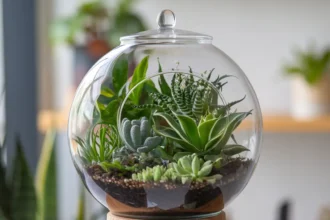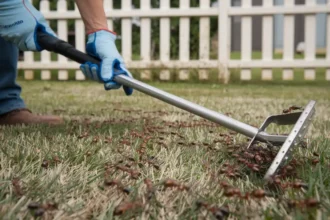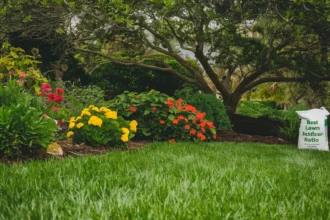When it comes to making your home brighter and adding a little extra joy to your living room, indoor plants can be the answer. Regardless of the space you have, there are easy-to-grow house plants for nearly any spot.
To assist you, we have made a list of the top plants for your living room. This way, you can select one (or more) that you really like. To know more about the importance of indoor plants, dive into this helpful guide.
1. Rubber Plant

This unique plant is easy to look after as its needs just the right amount of moisture, light, and warmth. Unlike a snake plant, a Rubber plant does well when kept a few feet from windows and loves having its leaves misted often.
A well-loved ornamental, it’s the perfect choice for people with a passion for design, as its beautiful leaves grow from 1ft to over 8ft.
Top tip: Available in different colours and sizes, their beautiful leaves make them a great choice to add beauty to your living room.
2. Bird of Paradise

This tropical plant requires full sunlight and does best in living rooms that have a stable temperature. Bird of Paradise has large leaves and needs enough room and a warm environment.
Beautiful to look at and needing water only once a week, this unique plant is easier to grow than most tropical plants. Just ensure this plant is placed where there is plenty of steady, bright light – for instance, close to a big window.
Top tip: This house plant would grow well in a room that faces the south.
3. Peace Lily

The Peace Lily is elegant and requires less attention. It is one of the most suitable living room for people with tight schedules.
It’s also one of the best indoor plants for living room, thanks to its beautiful white flowers. The plants can brighten up any space and make it more appealing.
It’s better with less water than too much, so you don’t need to worry about overwatering.
We understand that many of our readers love animals, so please keep in mind the harm Peace Lilies can present to pets.
Top tip: if dusts settles on your peace lily, use a wet paper towel to wipe it down gently.
4. Devil’s Ivy

Moving on, we have Devil’s Ivy as one of our favorite living room plants. It seem like a fern (a flowerless plant) indoors, but it does produce flowers on few occasions.
Don’t be fooled by the name, this adorable plant is very versatile and has beautiful heart-shaped vines, like Pothos, a heart-shaped climbing plant.
This plant is easy to care for and survives under almost any conditions – it’s called devil’s ivy because it can grow without much light and is hard to kill.
It stays green even in the dark and it’s one of the easiest plants to nurture. This makes it perfect for rooms with little sunlight. Wipe the leaves if you notice dust on them – this will keep them polished and help them get fresh air.
Top tip: The Devil’s Ivy can even grow well in artificial light.
5. Calathea Medallion

The calathea, loved by plant fans for its lovely patterns, is undoubtedly one of the prettiest real plants for the living room.
They grow best in humid places with low light and are harmless, making them a good choice in your parlor if you have young children or pets.
Top tip: Once the leaves begin to curl, it’s a sign that it needs more water. Keep the soil moist at all times, but ensure it doesn’t get too wet.
6. Monstera Deliciosa

Hailing from Central America and Mexico, this indoor plant stands out and looks amazing in any living room. The monstera is soft on the palm and loves warm rooms with some humidity.
Its big, heart-shaped leaves form holes over time and stay a good size when kept in a pot indoors. Ideal for colourful, trendy rooms, it does best in indirect light and needs to be watered at least once every week.
Top tip: Find out how to create a bold and lively living room for yourself.
7. Fiddle-Leaf Fig

The fiddle-leaf is undoubtedly one of the best plants you can use to decorate your living room. Their shiny, glossy leaves and slim trunk make them a perfect focal point.
The plant is the perfect choice for living rooms, as it can handle a bit of daily sunlight and grow well in regular room temperatures. It’s also a big hit online, with over 384,000 Instagram posts under the hashtag #fiddleleaffig.
8. Dracaena Compacta

If you have been thinking about how you can place plants in a living room that is not big enough, don’t worry. The dracaena is easy to care for and fits nicely in tight spaces because it grows tall and slim.
It can grow to a height of 3 feet or more.
Although they grow quite slowly like ZZ plants, don’t anticipate them to grow to their full size quickly. This plant can easily be kept in the same size pot for a very long period without needing to be moved to a bigger one.
This slender and stylish tree with its soft feel on the palm, grows best in medium to bright indirect light, making it great for corners.
Top tip: This beautiful succulent comes from Africa.
9. Spider Plant

The spider plant is flexible and one of the easiest houseplants to grow. It is one of our top living room plants because of its versatility. If you’re wondering how to put plants in the living room, there’s no wrong way to do it.
However, the majority of indoor plants will do better in certain places. For example, Spider plants thrive better on windowsills or high shelves because their long leaves hang over the pot, creating a lovely green display.
Top tip: These plants are also great at cleaning the air in your home, thus making them the ideal living room companion.
These are some of the house plans you can consider growing indoors. They are comfortable indoors and can thrive in your living room.
Other notable mentions include snake plant, Pothos, and Philodendron.
For more indoor gardening inspiration, check out:
How Plants Can Bring Good Luck and Improve Quality of Life
In the search for a plant that could bring a bit of good luck and prosperity into lives, the braided money tree may be the perfect choice. Known for its beautifully twisted trunk and vibrant leaves, this plant is often linked to positive energy and good fortune.
The money tree is also approved by feng shui, a traditional practice that uses natural elements to bring harmony.
Not only is the plant admired for its reputation in attracting good luck, but it has also been proven to be an effective air purifier. It’s safe for pets and children since it is non-toxic.
A great feature of the money tree is its ability to thrive under many lighting conditions. It can survive without direct sunlight, but it doesn’t like being kept in complete darkness either.

Plants are more than just decorative items in the home. They can have many benefits for people’s well-being.
Experts say that being surrounded by greenery can greatly reduce feelings of stress and anxiety. This is true whether people are outside in nature or simply enjoying the houseplants around them.
Indoor plants can create a calming atmosphere, which helps promote relaxation and improve mental health. This is especially beneficial when it’s not possible to get outside.
Caring for plants helps people feel better. Looking after houseplants is a special way to feel good. When people take care of plants, they think about the now.
Caring for plants helps people feel proud and happy, making them feel good in their minds. Plants also help clean the air.
They take away bad particles from the air, like formaldehyde, benzene, and trichloroethylene. This helps make the air fresh and clean, which is good for breathing.
The clean air helps people think better, remember things, and focus.
How Plants Enhance Wellbeing at Home
Plants are an easy way to improve both the look of a home and the health of the people living there. They bring color and vibrancy to any room, and they do so with little effort.
Whether people prefer plants like the Monstera Deliciosa or the Fiddle-Leaf Fig, plants add life to the home decor and improve the space’s atmosphere.
In addition to looking beautiful, plants can also improve people’s well-being.
Houseplants also contribute to the levels of humidity in the home. Plants help to prevent dryness in the nasal passages, throat, and skin just be releasing moisture into the air.
With this, people are less likely to experience discomfort or respiratory problems, especially in drier months.
Having houseplants can also help people feel more connected to nature.
This experience increases happiness and reduces stress. Experts say that spending time with plants helps create a peaceful, calming environment that improves mental well-being.

Some plants, like lavender and jasmine, have special properties that can improve sleep. These plants release soothing fragrances that help reduce anxiety and create a relaxing atmosphere. As a result, people may find it easier to fall asleep and enjoy restful, uninterrupted sleep.
How Rise and Recline Chairs Improve Comfort
One of the best ways for people to enjoy their houseplants is by sitting in a rise and recliner chair. These chairs are designed to help people with mobility issues stand up or sit back down with ease.
Experts say that rise and recline chairs are especially useful for people who struggle with joint pain or limited physical strength.
These chairs reduce the strain on muscles and joints, which makes it easier for people to move between sitting and standing positions.
They also offer excellent back support, ensuring people can sit in a position that suits their needs.
And even people who do not have mobility issues can benefit from their features. Using an electric riser recliner will make any room great for comfort and relaxation.
The Mental Health Benefits of Caring for a Houseplant
Being around greenery offers many benefits for people’s mental health. Horticultural therapy is often used to help treat mental health conditions. It is known to improve memory, concentration, and social skills.

Humans have an instinct to connect with nature, a concept known as biophilia. Experts explain that this connection is vital for improving mental health.
One plant owner, Nussman-Berry, shared how caring for plants provides a sense of purpose and routine. Nussman-Berry said it’s especially comforting during stressful times.
This routine is important for mental wellbeing because it gives people something to focus on, helping them to feel grounded and calm.
Plants are also known to lower blood pressure and improve productivity. Experts like Steinkopf explain that plants can reduce stress and anxiety, making it easier for people to stay focused and feel better.
“Houseplants have been shown to reduce psychological and physiological stress, enhance mood, and improve cognitive performance.”
Cromer, another expert, shared that caring for plants helps people feel more in control of their lives. It allows people to observe how the plant grows and troubleshoot any issues they may encounter.
Plants are good at boosting confidence, too. When people see their plants grow and thrive, they feel proud of their efforts.
For example, learning how to care for a houseplant like the prayer plant can be a soothing and rewarding experience — check out this Prayer Plant Care Guide for helpful tips.
Moreover, plants are non-stimulating and accepting, which makes them great companions for anyone looking for something calming and easy to care for.
How Plants Are Good Listeners
One of the most special qualities of plants is their simple nature. They do not demand much attention, yet they reward people with beautiful growth. Plants provide a calming presence, and experts explain that they offer a non-judgmental environment.
By just giving plants water and sunlight, people help them grow. This easy, low-maintenance care is relaxing and fulfilling, making plants ideal for reducing stress.

Plants are important to humans as they add beauty and life to the world. Imagine a world without plants, or an environment without plants.
Plants should be taken care of, as they take care of humans and animals by improving the air and making the environment more beautiful.
Plants provide an environment that is healthy and peaceful, which can be beneficial to humans and animals’ overall wellness.






